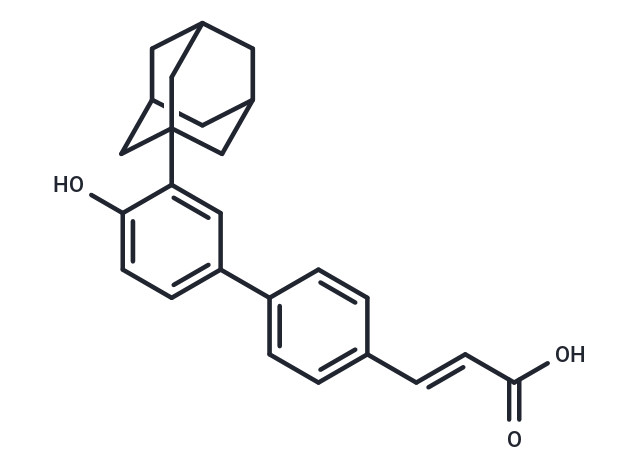Shopping Cart
- Remove All
 Your shopping cart is currently empty
Your shopping cart is currently empty

Adarotene (ST1926) is an effective apoptosis inducer. It surprisingly produces DNA damage and exhibits a potent antiproliferative activity on a large panel of human tumor cells.

| Pack Size | Price | Availability | Quantity |
|---|---|---|---|
| 1 mg | $32 | In Stock | |
| 2 mg | $45 | In Stock | |
| 5 mg | $74 | In Stock | |
| 10 mg | $133 | In Stock | |
| 25 mg | $255 | In Stock | |
| 50 mg | $411 | In Stock | |
| 100 mg | $597 | In Stock | |
| 500 mg | $1,280 | In Stock | |
| 1 mL x 10 mM (in DMSO) | $75 | In Stock |
| Description | Adarotene (ST1926) is an effective apoptosis inducer. It surprisingly produces DNA damage and exhibits a potent antiproliferative activity on a large panel of human tumor cells. |
| In vitro | Adarotene causes cell accumulation in the G1/S or S phase of the cell cycle depending on tumor cells IGROV-1 and DU145. Adarotene causes dose-dependent growth inhibition in a large panel of human tumor cell lines with IC50 ranging from 0.1 to 0.3 μM [1]. Adarotene is apoptotic and cytotoxic on a large spectrum of cancerous and leukemic cells, including freshly isolated AML blasts in primary culture. Adarotene treatment of cells results in rapid accumulation of intracellular calcium [2]. |
| In vivo | Adarotene, administered orally at doses of 30 and 40 mg/kg, significantly extends the lifespan of NB4-bearing SCID mice in a dose-dependent manner without apparent toxicity [2]. At lower doses of 15 and 20 mg/kg, it markedly inhibits tumor growth in human ovarian carcinoma (A2780/DX) and human melanoma (MeWo) models in nude mice [1]. |
| Alias | ST1926 |
| Molecular Weight | 374.47 |
| Formula | C25H26O3 |
| Cas No. | 496868-77-0 |
| Smiles | OC(=O)\C=C\c1ccc(cc1)-c1ccc(O)c(c1)C12CC3CC(CC(C3)C1)C2 |
| Relative Density. | 1.257 g/cm3 |
| Storage | Powder: -20°C for 3 years | In solvent: -80°C for 1 year | Shipping with blue ice. | |||||||||||||||||||||||||||||||||||
| Solubility Information | DMSO: 45 mg/mL (120.17 mM), Sonication is recommended. | |||||||||||||||||||||||||||||||||||
Solution Preparation Table | ||||||||||||||||||||||||||||||||||||
DMSO
| ||||||||||||||||||||||||||||||||||||

Copyright © 2015-2025 TargetMol Chemicals Inc. All Rights Reserved.